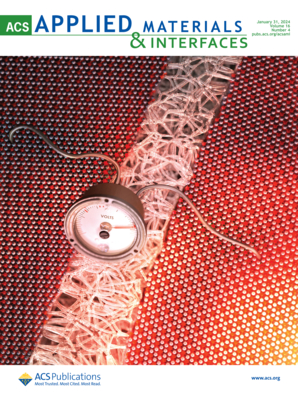Saponin Gallate-Loaded Gd-Doped Zinc–Gallium Layered Double Hydroxides (Zn/Ga@Gd-LDH) Nanocarrier for Attenuating NF-κB-Mediated Inflammation
IF 8.3
2区 材料科学
Q1 MATERIALS SCIENCE, MULTIDISCIPLINARY
引用次数: 0
Abstract
This work describes a drug delivery system (DDS) based on the therapeutic anti-inflammatory efficacy of saponin gallate (SG), a combination of gallic acid and saponin, chemically conjugated via an ester linkage. This formulation was loaded onto a biocompatible gadolinium-doped zinc–gallium-layered double hydroxide (Zn/Ga@Gd-LDH) nanocarrier. FT-IR, XRD, SEM, and HPLC were used to characterize the synthesized materials. UV–visible spectroscopy was employed to investigate the drug release from SG-Zn/Ga@Gd-LDH at an optimized temperature (45 °C) and pH (5). The kinetic release behavior of SG-Zn/Ga@Gd-LDH nanoparticles suggested that the first-order kinetic model was the most appropriate for the release profile. The regression value (R2) of 0.96614 indicated an optimal and controlled release for therapeutic effectiveness and minimal adverse effects over 54 h. The in vitro and in vivo models confirmed that drug-loaded nanocarriers exhibited antioxidant, anti-inflammatory, and anticancer properties. Western blotting analysis suggested that SG-Zn/Ga@Gd-LDH abrogates the anti-inflammatory properties by halting the phosphorylation of pro-inflammatory proteins p-p65 and decreasing CRP levels involved in the NF-κB pathway. SG-Zn/Ga@Gd-LDH exhibited an anti-inflammatory effect by reducing the secretion of proinflammatory cytokines. SG-Zn/Ga@Gd-LDH treatment against an acute CCl4-induced liver injury model showed anti-inflammatory potential in histological parameters’ study. Radiolabeling of the drug saponin gallate with 99mTc was carried out to determine its in vivo biodistribution. The chromatographic results indicated promising radiolabeling of up to 90% percentages. SPECT-CT imaging and ex vivo gamma counting in Wistar rats revealed different clearance rates of nanoparticles, aiding in the evaluation of the drug delivery nanosystem. The designed system also demonstrated antioxidant potential due to the SG compound having IC50 127.45 μg/mL free radical scavenging activity. Ga@Gd-LDH showed a tumor-suppressing ability of 79.89 ± 3.91% for viable cells against breast cancer MCF-7 cells. The developed formulation could thus be a conducive strategy against inflammatory diseases.

皂素没食子酸盐负载掺杂钆的锌镓层状双氢氧化物(Zn/Ga@Gd-LDH)纳米载体用于减轻 NF-κB 介导的炎症反应
本文章由计算机程序翻译,如有差异,请以英文原文为准。
求助全文
约1分钟内获得全文
求助全文
来源期刊

ACS Applied Materials & Interfaces
工程技术-材料科学:综合
CiteScore
16.00
自引率
6.30%
发文量
4978
审稿时长
1.8 months
期刊介绍:
ACS Applied Materials & Interfaces is a leading interdisciplinary journal that brings together chemists, engineers, physicists, and biologists to explore the development and utilization of newly-discovered materials and interfacial processes for specific applications. Our journal has experienced remarkable growth since its establishment in 2009, both in terms of the number of articles published and the impact of the research showcased. We are proud to foster a truly global community, with the majority of published articles originating from outside the United States, reflecting the rapid growth of applied research worldwide.
 求助内容:
求助内容: 应助结果提醒方式:
应助结果提醒方式:


